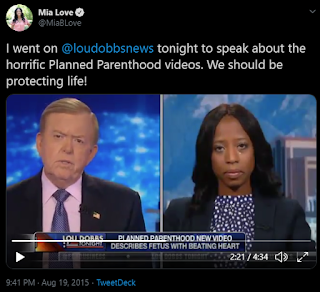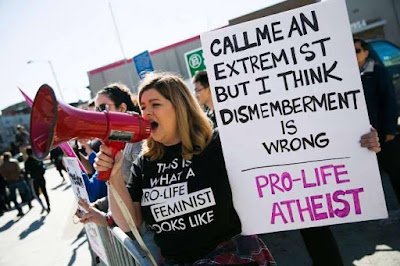Former Abortionist Kathi Aultman on Dehumanization
 |
| Dr. Aultman |
Kathi Aultman is a former abortionist who told her story in an interview with Lila Rose from Live Action. Aultman was strongly pro-choice when she entered medical school. A doctor she really admired committed late-term abortions, and she was eager to learn from him. She bought into the pro-abortion argument that women’s bodily autonomy gave them the right to have abortions.
She liked the challenge of doing abortions and was not put off by doing them late in pregnancy:
I was challenged by the procedure and I really hate to say this, but the bigger the better. I cringe now when I say that, but I wanted to do the biggest ones I could. It was a challenge, and my whole focus was being good at what I did and stretching the limits.
She did not see the babies she aborted as human beings:
I think part of the problem was that I didn’t see a fetus any [differently] than a chick embryo. The chick embryos that we dissected in college. And I didn’t see them as human beings.
She did not feel any emotional conflict about tearing preborn babies apart. In fact, she was fascinated by the babies’ bodies:
As a matter of fact, and again I hate to admit this, but when I would look at the parts that I had taken out, I was fascinated with them. I thought, “Oh, these are so cute. And they’re great, they’ve got little fingers and toes.”
… I just wanted to find out everything about them that I could. But I did not see them as human beings. I just saw them as embryos and fetuses. Not as people.
Aultman became pregnant. She continued to do abortions throughout her pregnancy:
I got pregnant while I was in residency, and I was moonlighting at an abortion clinic at the time doing abortions. And I was almost proud of the fact that here I was pregnant, and I was still doing abortions. I felt like, well, my baby is wanted, theirs is not. They have the right to abort their babies. And so, I continued to do abortions during my whole pregnancy.
But when the baby was born, Aultman found that her attitude had shifted. Things about her work that hadn’t bothered her in the past began to trouble her. She stopped doing abortions because of three women she encountered.
She describes the first woman:
The first one was a young girl that came in, and she was scheduled that morning. I had done three abortions on her myself… And she had had other abortions that I didn’t do, but I had done three of them. And I told the people at the clinic that I didn’t want to do it. And they said, “You don’t have the right to judge. It’s her choice. If she wants to use abortion as birth control, that’s up to her.”
I looked at them, and I said, “Yeah, but I’m the one that’s having to do the killing.” So, I ended up doing the abortion, and afterwards I tried to get her to take birth control and she refused, so she left.
Finally, Aultman was starting to see what she was doing as killing. The casual attitude of the woman using abortion as birth control troubled her. The next encounter was with a woman who had a similar attitude:
Then the next woman came in with a friend, and sometimes people did want to see the tissue. And the friend said, “Do you want to see the tissue?” And she said, “No. I just want to kill it.”
And it just hit me, like cold water in the face. And I thought, “What did this baby do to you?” It’s not the baby’s fault.
The third woman was a mother of four who really wanted to keep the baby. She and her husband didn’t believe they could afford a fifth child. Pressured by financial circumstances, the woman was forced to “choose” abortion. She cried the entire time she was at the abortion facility. Aultman was able to see how little choice this woman had and how devastated she was by her abortion. Aultman says, “Thankfully, she was my last patient, because I just — I couldn’t do them after that.”
She says:
I think I had finally made that baby = fetus connection. And I realized that that was a little person, just like my daughter was a little person. And the fact that they were no longer wanted was not enough for me to kill them.
Aultman quit and resolved never to do abortions again. But she was still pro-choice. She still supported keeping abortion legal and would refer patients for abortions, even if she wouldn’t do them herself.
Aultman had always believed the pro-choice narrative that young girls needed abortion because a baby would destroy their lives. But what she saw in her practice proved otherwise:
It wasn’t until I started to see young girls in my practice who had babies and did really well. I had always thought that an unplanned pregnancy for a young girl was the worst thing that could happen to her. That’s sort of the normal thinking…
That’s the narrative. And to see these girls do so well. And then I had other patients who were seeing psychiatrists or were struggling with the physical complications of abortions. And it just wasn’t what I expected. It didn’t jive with the rhetoric, the rhetoric that I had embraced.
Aultman became a Christian and began going to church. Her new beliefs had no effect on her pro-choice views. But she saw young girls in her church have babies. Just like the young girls in her practice, these young women’s lives were not destroyed by their children. She got to know the babies and watched them grow, all the while knowing that had their mothers been her patients, she would’ve encouraged them to abort. She says:
And as I watched those little children grow up into these wonderful people, I began to again see, okay, these are real people that we are killing. Who never get a chance to be alive. And we never get to see who they’re going to become.
But the final, pivotal event that won her to the pro-life cause was reading an article given to her by some pro-life friends.
The article drew a parallel between the Holocaust in Nazi Germany and abortion in America today. Although abortion and the Holocaust are very different, the article pointed out that both were enabled to happen because people did not see the victims as human beings. Both preborn babies and the victims of the Holocaust were dehumanized. Aultman says:
My dad was with… the group that [liberated] the first concentration camp during World War II. And so, I grew up with all those stories and those horrific pictures. And then, when I became a doctor, I couldn’t understand how the German doctors could do the things that they did…
When I read that comparison between the Holocaust and abortion, I finally understood how they could do the horrible things that they did. Because just as I didn’t see the fetus as a person, they didn’t see the Jews and the Gypsies and the others as people. And if you don’t consider someone human, you can do anything you want.
That’s when I realized that I was a mass murderer. I had killed all of these people. And that’s when I completely changed my opinion on abortion.
Aultman made the connection between the dehumanization of babies in the womb and the dehumanization of other victims of violence.
She struggled to cope with the guilt and remorse she felt for killing so many people. It took years of therapy, reflection, prayer, and spiritual guidance for her to come to terms with what she had done. Now Aultman is pro-life and speaks out against abortion.
She says that she is far from the only former abortionist, but most former abortionists never tell their stories:
[N]ot many people can continue to do abortions. They may do them during their residency training, but very few of them go on to do abortions because the normal human cannot be ripping apart and killing other human beings for very long, if you have a conscience. And that’s why there aren’t that many abortionists, because people just can’t continue to do it. Something happens along the way, where they see the light, and they realize what they are doing.
Most former abortionists, she says, keep quiet because of the stigma of abortion and their shame in taking part in so many deaths. Many of the ones still in practice know that women don’t want their babies delivered by an abortionist or former abortionist. They fear losing their patients, and they fear the judgment of people in their lives.
Aultman speculates that if more doctors spoke out about their experiences, it would greatly help the pro-life movement. It is important for the pro-life movement to create a welcoming environment that encourages former abortion doctors to tell their stories.
At the end of the interview, Aultman encourages those currently doing abortions to feel the same compassion for the babies that they feel for the mothers:
So you’re thinking you’re helping this poor woman. There are alternatives for her, okay? There aren’t any alternatives for the baby. So you’re, in order not to inconvenience this person, or make her feel bad about “giving her baby away” or whatever, you’re then taking the life of this other person, who never gets to experience the light of day. Never can grow up and be who they’re supposed to be. So, have as much compassion for the baby as you do for this woman.
She also reminds pro-lifers of the importance of reaching out to people on the other side with compassion:
It wasn’t people yelling at me, berating me, trying to make me feel guilty, that’s not what changed my opinion. It was people loving me, even though I was pro-abortion and me respecting them and then them telling me, “well, maybe you should consider this.”
Aultman’s conversion was a process, and it took time. Pro-life friends, such as the ones that shared the article, were pivotal in opening her eyes. Pro-lifers need to approach pro-choicers with respect and compassion and be willing to befriend them. Many times, it is through friendship that conversions happen.
You can watch the full interview and read the transcript here.
[Today’s guest article is by Sarah Terzo of ClinicQuotes. If you want to contribute an article to the Secular Pro-Life blog, check out our submission guidelines.]



Leave a Reply
Want to join the discussion?Feel free to contribute!